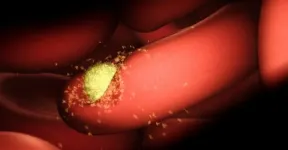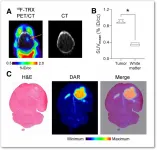Cascaded metasurfaces for dynamic control of THz wavefronts
Dynamic control of THz wavefronts demonstrated by rotating layers of cascaded metasurfaces
2021-07-23
(Press-News.org) Electromagnetic (EM) waves in the terahertz (THz) regime contribute to important applications in communications, security imaging, and bio- and chemical sensing. Such wide applicability has resulted in significant technological progress. However, due to weak interactions between natural materials and THz waves, conventional THz devices are typically bulky and inefficient. Although ultracompact active THz devices do exist, current electronic and photonic approaches to dynamic control have lacked efficiency.
Recently, rapid developments in metasurfaces have opened new possibilities for the creation of high-efficiency, ultracompact THz devices for dynamic wavefront control. Ultrathin metamaterials formed by subwavelength planar microstructures (i.e., meta-atoms), metasurfaces enable tailored optical responses for control of EM wavefronts. By constructing metasurfaces that possess certain predesigned phase profiles for transmitted or reflected waves, scientists have demonstrated fascinating wave-manipulation effects, such as anomalous light deflection, polarization manipulation, photonic spin-Hall, and holograms.
Moreover, integrating active elements with individual meta-atoms inside passive metasurfaces allows for "active" metadevices that can dynamically manipulate EM wavefronts. While active elements in deep subwavelengths are easily found in the microwave regime (e.g., PIN diodes and varactors), and successfully contribute to active metadevices for beam-steering, programmable holograms, and dynamic imaging, they are difficult to create at frequencies higher than THz. This difficulty is due to size restrictions and significant ohmic losses in electronic circuits. Although THz frequencies can control THz beams in a uniform manner, they are typically unable to dynamically manipulate the THz wavefronts. This is ultimately due to deficiencies in the local-tuning capabilities at deep-subwavelength scales in this frequency domain. Therefore, developing new approaches that bypass reliance on local tuning is a priority.
As reported in Advanced Photonics, researchers from Shanghai University and Fudan University developed a general framework and metadevices for achieving dynamic control of THz wavefronts. Instead of locally controlling the individual meta-atoms in a THz metasurface (e.g., via PIN diode, varactor, etc.), they vary the polarization of a light beam with rotating multilayer cascaded metasurfaces. They demonstrate that rotating different layers (each exhibiting a particular phase profile) in a cascaded metadevice at different speeds can dynamically change the effective Jones-matrix property of the whole device, achieving extraordinary manipulations of the wavefront and polarization characteristics of THz beams. Two metadevices are demonstrated: the first metadevice can efficiently redirect a normally incident THz beam to scan over a wide solid-angle range, while the second one can dynamically manipulate both wavefront and polarization of a THz beam.
This work proposes an attractive alternative way to achieve low-cost dynamic control of THz waves. The researchers hope that the work will inspire future applications in THz radar, as well as bio- and chemical sensing and imaging.
INFORMATION:
Read the open access article, "Dynamically controlling terahertz wavefronts with cascaded metasurfaces," Adv. Photonics, 3(3), 036003 (2021), doi 10.1117/1.AP.3.3.036003.
[Attachments] See images for this press release:

ELSE PRESS RELEASES FROM THIS DATE:
2021-07-23
SAN FRANCISCO, CA--July 22, 2021--To speed up a chemical reaction, a chemist might place the reactants over a Bunsen burner. Adding heat increases the degree of random movements and collisions of particles, accelerating the reaction.
In cell biology, one important "reaction" is the transformation of stem cells into all the other cells in the body, a process known as differentiation. Gladstone Institutes researchers have now discovered a molecular mechanism that acts like a Bunsen burner to "turn up the heat" and accelerate differentiation.
However, instead of boosting temperature, this process amplifies random fluctuations ...
2021-07-23
New York, NY (July 23, 2021) -- Mount Sinai researchers have developed a therapeutic agent that shows high effectiveness in vitro at disrupting a biological pathway that helps cancer survive, according to a paper published in Cancer Discovery, a journal of the American Association for Cancer Research, in July.
The therapy is an engineered molecule, named MS21, that causes the degradation of AKT, an enzyme that is overly active in many cancers. This study laid out evidence that pharmacological degradation of AKT is a viable treatment for cancers with mutations in certain genes.
AKT is a cancer gene that encodes an enzyme that is frequently abnormally activated in cancer cells to stimulate tumor growth. Degradation of ...
2021-07-23
Advanced technologies have been used to solve a long-standing mystery about why some people develop serious illness when they are infected with the malaria parasite, while others carry the infection asymptomatically.
An international team used mass cytometry - an in-depth way of characterising individual cells - and machine learning to discover 'immune signatures' associated with symptomatic or asymptomatic infections in people infected with the Plasmodium vivax parasite. This uncovered an unexpected role for immune T cells in protection against malaria, ...
2021-07-23
How does a view of nature gain its gloss of beauty? We know that the sight of beautiful landscapes engages the brain's reward systems. But how does the brain transform visual signals into aesthetic ones? Why do we perceive a mountain vista or passing clouds as beautiful? A research team from the Max Planck Institute for Empirical Aesthetics has taken up this question and investigated how our brains proceed from merely seeing a landscape to feeling its aesthetic impact.
In their study, the research team presented artistic landscape videos to 24 participants. Using functional magnetic resonance imaging (fMRI), they measured the participants' brain activity as they viewed and rated the videos. Their findings have just been published in the ...
2021-07-23
As Xi'an Jiaotong-Liverpool University researchers completed their research on coloured architectural concrete, they found a surprising result--green pigmented cement had impurities that produced porous, poor quality concrete. Meanwhile, red and blue pigments had little effect.
The research was conducted by Mehreen Heerah, a graduate of XJTLU's Department of Civil Engineering, Dr Graham Dawson of XJTLU's Department of Chemistry, and Isaac Galobardes of Mohammed VI Polytechnic University.
Pigmented architectural concrete is used as a visually appealing alternative to grey concrete, such as in Barcelona's Ciutat de la Justícia, explains Dr Dawson. As the demand for pigmented architectural concrete grows, so does the importance of this research.
Not easy ...
2021-07-23
New research from the University of Otago debunks a long-held belief about our ancestors' eating habits.
For more than 60 years, researchers have believed Paranthropus, a close fossil relative of ours which lived about one to three million years ago, evolved massive back teeth to consume hard food items such as seeds and nuts, while our own direct ancestors, the genus Homo, is thought to have evolved smaller teeth due to eating softer food such as cooked food and meats.
However, after travelling to several large institutes and museums in South Africa, Japan and the ...
2021-07-23
About six gigatons -- roughly 12 times the mass of all living humans -- of carbon appears to be emitted over land every year, according to data from the Chinese Global Carbon Dioxide Monitoring Scientific Experimental Satellite (TanSat).
Using data on how carbon mixes with dry air collected from May 2017 to April 2018, researchers developed the first global carbon flux dataset and map. They published their results in Advances in Atmospheric Sciences.
The map was developed by applying TanSat's satellite observations to models of how greenhouse gasses are exchanged among Earth's atmosphere, land, ...
2021-07-23
Reston, VA--A new radiotracer that detects iron in cancer cells has proven effective, opening the door for the advancement of iron-targeted therapies for cancer patients. The radiotracer, 18F-TRX, can be used to measure iron concentration in tumors, which can help predict whether a not the cancer will respond to treatment. This research was published in the July issue of the Journal of Nuclear Medicine.
All cancer cells have an insatiable appetite for iron, which provides them the energy they need to multiply. As a result, tumors have higher levels of iron than normal tissues. Recent advances in chemistry have led scientists to take advantage of this altered state, targeting the expanded cytosolic ...
2021-07-23
MUSC Hollings Cancer Center was one of 28 clinical sites around the world that participated in the LOTIS-2 trial to test the efficacy of Loncastuximab tesirine, a promising new treatment for aggressive B-cell lymphoma. The results of the single-arm, phase 2 trial were published online in May 2021 in Lancet Oncology.
Brian Hess, M.D., a Hollings researcher and lymphoma specialist at MUSC Health, was instrumental in bringing the phase 2 trial to Hollings. The manufacturer of Loncastuximab tesirine, ADC Therapeutics S.A., sponsored the trial.
B-cell non-Hodgkin lymphoma (NHL) is a blood cancer that begins in the lymph nodes, spleen or bone marrow. Diffuse large B-cell lymphoma (DLBCL) is the most common subtype of aggressive NHL. New treatment options are vital for patients with DLBCL. ...
2021-07-23
Due to the global efforts to meet sustainability standards, many countries are currently looking to replace concrete with wood in buildings. France, for example, will require that all new public buildings will be made from at least 50 percent wood or other sustainable materials starting in 2022.
Because wood is prone to degradation when exposed to sunlight and moisture, protective coatings can help bring wood into wider use. Researchers at Aalto University have used lignin, a natural polymer abundant in wood and other plant sources, to create a safe, low-cost and high-performing coating for use in construction.
'Our new coating has great potential to ...
LAST 30 PRESS RELEASES:
[Press-News.org] Cascaded metasurfaces for dynamic control of THz wavefronts
Dynamic control of THz wavefronts demonstrated by rotating layers of cascaded metasurfaces





